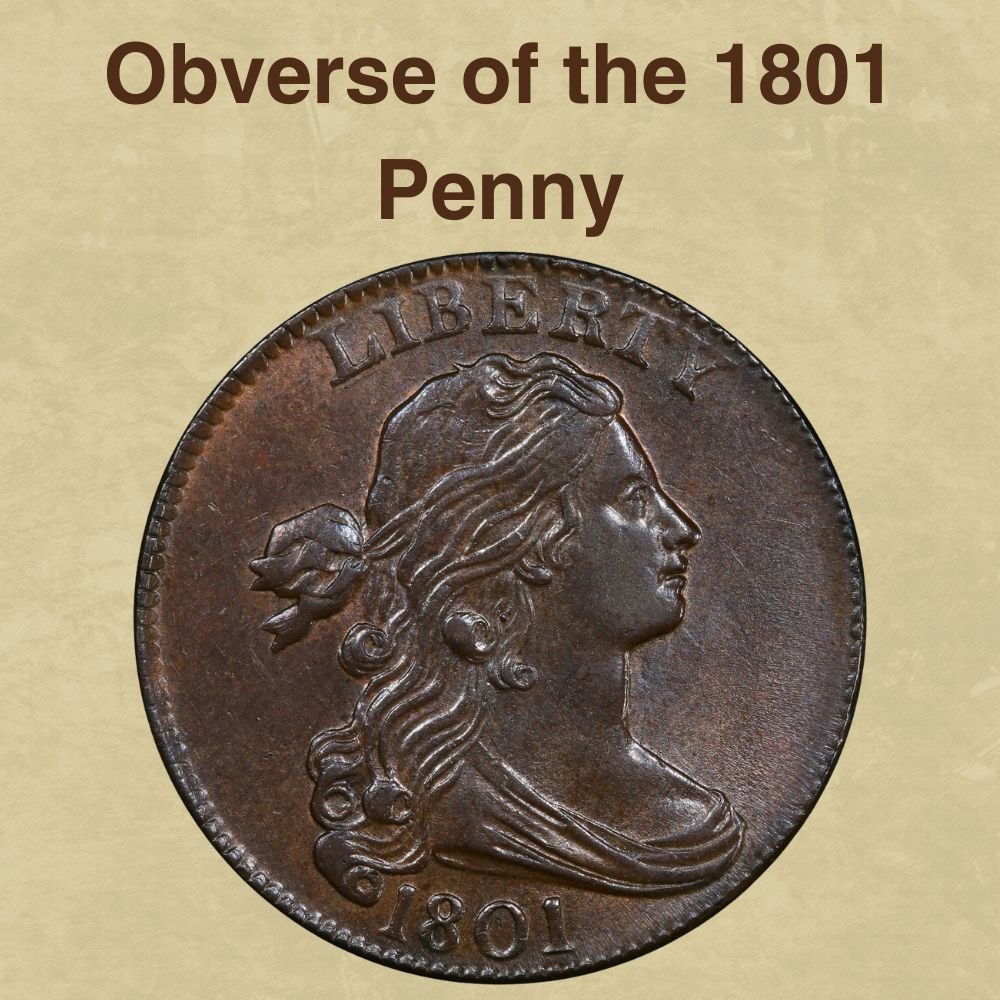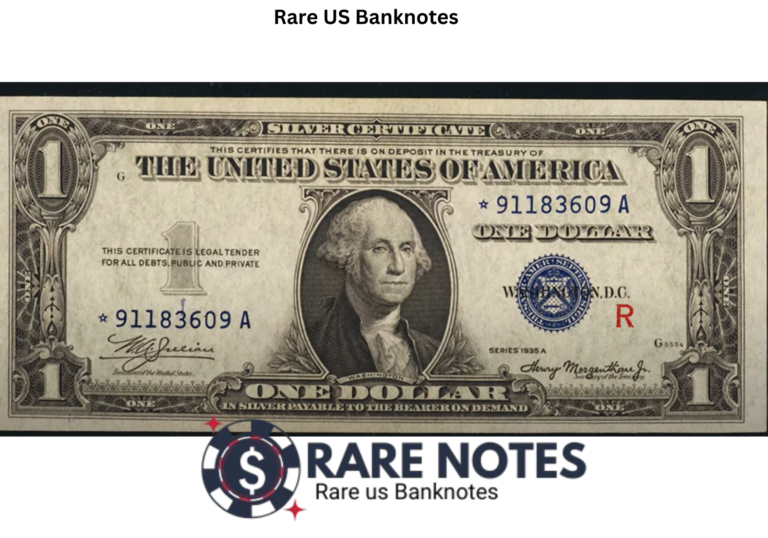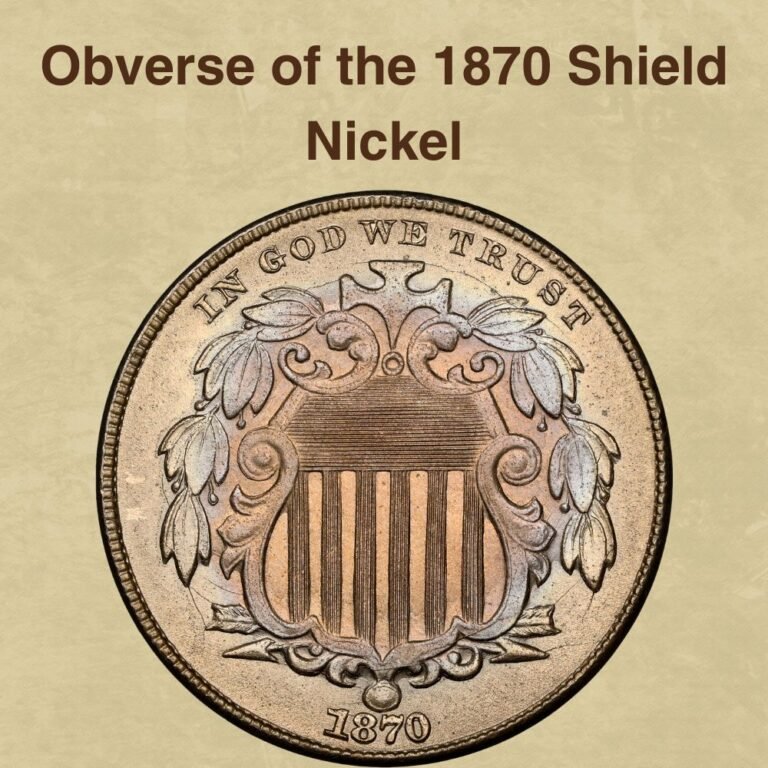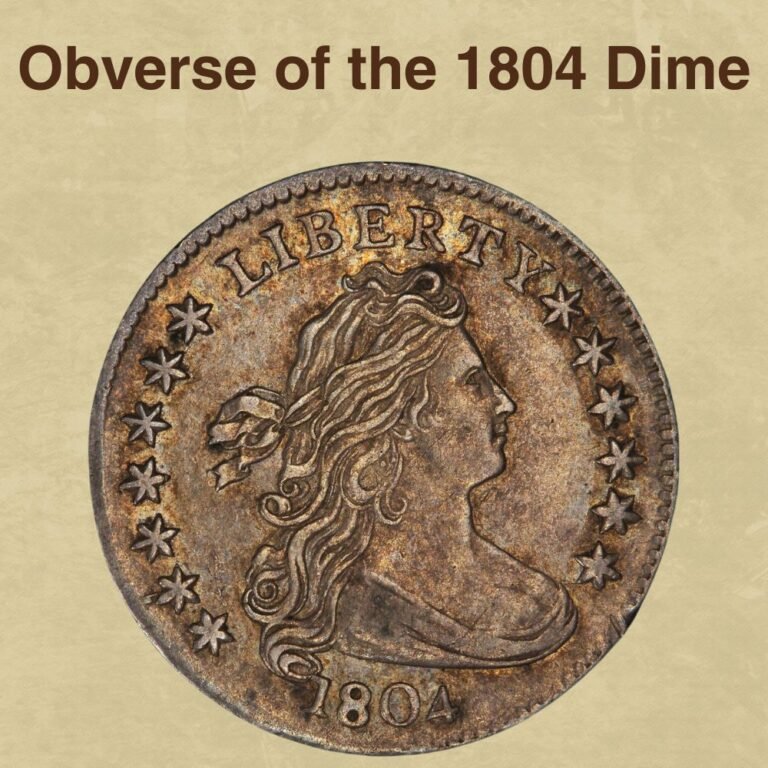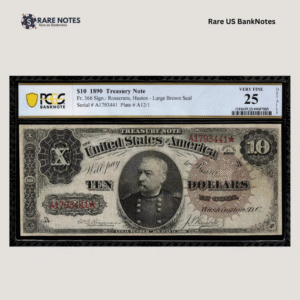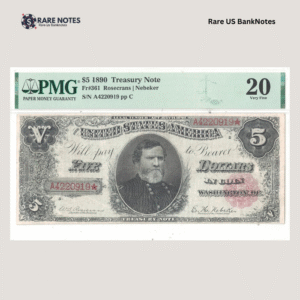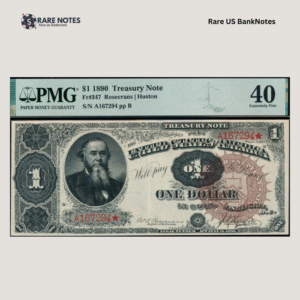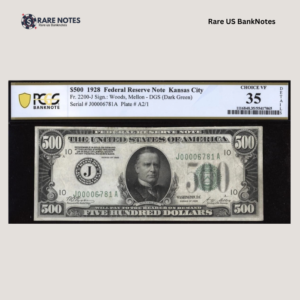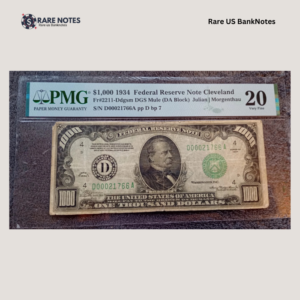Are you collecting Draped Bust large cents, also known as pennies? Has the 1801 issue piqued your interest, and are you curious whether it’s worth any money? You’ve come to the right place! Our guide will explain everything you need to know about the 1801 penny value.
We’ll walk you through the most valuable die varieties and reveal tips for grading your copper coin. You’ll also learn a bit about the history of the Draped Bust coin series, to which the 1801 penny belongs.
So, without further ado, let’s jump in and find out: How much is the 1801 penny worth today?
1801 Penny Value Chart |
||||
| Mint Mark | Good | Fine | Extremely Fine | Uncirculated |
| 1801 Penny Value | $99 | $470 | $2,200 | $28,000 |
| 1801 Penny 3 Errors Variety Value | $360 | $1,450 | $6,900 | $225,000 |
| 1801 Penny 1/1000 Variety Value | $215 | $575 | $3,900 | $41,000 |
History of the 1801 Penny
The 1801 penny is part of the popular Draped Bust coin series, which the United States Mint struck from 1796 to 1807. The Draped Bust design replaced the Flowing Hair design, which had received widespread criticism. And so, in 1796, Congress authorized the Mint to create a new design that would be featured on both copper and silver coinage.
The then Mint Chief Engraver, Robert Scot, went to work and transformed a portrait by the renowned artist Gilbert Stuart of Anne Willing Bingham. Ms. Bingham, whose image would represent Lady Liberty, was a well-known Philadelphia socialite and the wife of statesman William Bingham. For the Draped Bust design, Scot turned Lady Liberty into a bustier, more feminine model, and this image, featured on the obverse, remained unchanged for several years. The reverse design on the copper coins of the Draped Bust series features a wreath surrounding the coin’s denomination.
Due to poor working conditions and unadvanced technology, the Draped Bust coinage, including the 1801 penny, has numerous minting errors and die varieties, which we will look at in a bit. Although many minting errors and varieties are not of interest to collectors and aren’t worth much, some are quite valuable and can significantly add to the value of your collection.
The 1801 Draped Bust penny is not a rare date, but some standout die varieties found in this issue greatly increase its demand among collectors. So, this date is certainly a worthwhile addition to your collection.
Also read: 12 Most Valuable Lincoln Penny Worth Money
Features of the 1801 Penny
Next, we’ll look at the features of the 1801 penny. By knowing these features, you can tell a fake penny from a real one, grade your coin more accurately, and identify Draped Bust coins worth good money.
So, here’s what to look out for:
Obverse of the 1801 Penny

The “heads” features Lady Liberty’s right-facing portrait, in which she is dressed in drapery that highlights her bosom. Her hair flows lightly with some strands combed up over her forehead and others held back with a ribbon.
The word LIBERTY is inscribed above her along the rim, while the date, 1801, is etched below, also along the rim.
Reverse of the 1801 Penny

When you turn the coin over on its “tails,” you’ll find a wreath whose branches are tied together at the bottom with a ribbon.
At the center, surrounded by the wreath, is the coin’s denomination, etched as ONE CENT. This is further represented by a small fraction, 1/100, nestled just underneath the ribbon. The words UNITED STATES OF AMERICA surround the entire wreath image.
Tiny, numerous denticles decorate both the obverse and reverse rims.
Other Features of the 1801 Penny
In addition to these standout features, other extra features worth noting are:
- Diameter:28.00 millimeters
- Weight: 10.89 grams
- Edge: Plain
- Metal Composition: Copper
Also read: 13 Most Valuable Wheat Penny Worth Money
1801 Penny Value Guides
Now, let’s find out: How much is a 1801 penny worth? The value depends on the coin’s condition, grade, and rarity. The presence of minting errors and die varieties can also add a significant premium to your old penny.
The 1801 Draped Bust penny stands out for its die varieties, which are in high demand among collectors. We’ll explore the following:
- 1801 Penny
- 1801 3 Errors Variety
- 1801 1/1000 Variety
Let’s dive in and discover how much each is worth.
1801 Penny Value

The Mint in Philadelphia struck approximately 1,362,837 Draped Bust copper pennies in 1801. Such a mintage was considered to be high at the time, making this issue more common than one would expect of a classic coin.
Here’s what to expect in terms of the 1801 penny value:
- Circulated Examples: Worn examples are common in lower grades but become pointedly scarce in Extremely Fine (XF) and higher. Most survivors can be added to any collection affordably. In Poor/Average condition, examples are worth up to $65 and as much as $99 in Good (G) condition. Prices rise to as much as $470 in Fine (F) and up to $2,220 for Extremely Fine (XF) examples. About Uncirculated examples are very scarce and highly sought after, with values rising to at least $5,500 for AU58 specimens.
- Mint State Examples: Uncirculated examples are scarce in lower grades and very rare in higher grades. Gems are extremely difficult to find, if any exist at all. Prices can be prohibitive even in lower grades, with examples graded MS60 selling for up to $9,475 while those in MS62 fetch at least $12,500. Specimens graded MS63 and higher are extremely rare, with prices ranging from as high as $19,100 for MS63 to $28,000 for MS64. Examples finer than MS64 are currently unknown.
- Auction Record: In a 2008 sale, Heritage Auctions sold an AU58 for a record-breaking $103,500, making this one of the most valuable examples of a circulated 1801 penny.
1801 3 Errors Variety Value

Some 1801 Draped Bust cents show three distinctive die errors. On these coins, the denomination fraction reads “1/1000” instead of “1/100”, the left side stem close to the ribbon is missing, and the letter “U” in UNITED is punched upside down, making it appear like “II.”
Examples with this error are rarer than regular pennies without the die errors. As such, the “three errors” 1801 pennies are pricier and more sought after.
Here’s what to expect:
- Circulated Examples: So rare and valuable is the 3 errors die variety that even lower grade examples command high prices. For instance, a Poor/Average example can sell for as much as $165 while one in Good (G) condition can fetch up to $360. A Fine (F) example is worth at least $1,450 while one graded Extremely Fine (XF) can sell for as much as $6,900. About Uncirculated (AU) examples are genuinely rare, commanding prices as high as $28,500 in AU58.
- Mint State Examples: These are extremely rare, and the only known example is a brown MS63, which the Numismatic Guaranty Company (NGC) values at $225,500.
- Auction Record: According to records by the Professional Coin Grading Service (PCGS), Heritage Auctions sold an MS63 (Brown) in 2005 for a record $138,000, but this eventually was surpassed by the NGC specimen.
1801 Penny 1/1000 Variety Value

Another sought-after type of 1801 penny is the 1/1000, which resulted from a die error that misrepresented the denomination fraction. Although scarcer than the regular 1801 penny, this variety is more common than the “3 Errors” type and can be affordably added to any collection.
Here’s what to expect:
- Circulated Examples: These make up a fairly large portion of the population of 1801 penny survivors. Lower-grade examples are relatively affordable and accessible to most collectors. Prices start from as low as $90 for pennies graded Poor/Average and rise to $215 in Good (G) condition, while (F) examples can fetch as much as $575. Extremely Fine (XF) examples are increasingly scarce, commanding premiums of up to $3,900, while rare About Uncirculated (AU) examples are worth at least $8,250.
- Mint State Examples: Uncirculated specimens are rare, and any examples higher than MS63 are unknown currently. In MS60, examples can sell for as much as $12,750, with prices shooting to $15,500 in MS62 and up to $41,000 in MS63. Gems are extremely difficult to find, and none have been discovered to date.
- Auction Record: In 2008, Superior Galleries auctioned an MS60 for an impressive $33,350, making this one of the most valuable examples of 1801 pennies in that grade.
1801 Penny Grading
The 1801 Draped Bust penny is made from copper, so when grading, you should pay attention to the coin’s color, wear, and surface quality for any signs of corrosion.
Circulated examples will have a brownish patina, less worn pennies will appear reddish-brown, while rare, uncirculated examples will display a brilliant red surface. Surface quality issues, such as pitting and corrosion, usually lower the coin’s grade.
Check the extent of wear on high contact points, including Lady Liberty’s hair strands above her forehead and behind her ear, the bust area, and the ribbon. On the reverse, pay attention to the details of the wreath leaves and the ribbon. If Liberty’s details are bold and clear, and so are the wreath leaves, the coin is likely a Very Fine (VF) example or higher, but if these details appear weak and almost invisible, it is probably a Good (G) example or lower.
To be sure, you can do a side-by-side comparison of your coin against photos of a similar coin from trusted sources such as the PCGS or NGC.
Rare 1801 Penny Errors List
The Draped Bust coinage series is known for the numerous minting errors and die varieties. While most of these errors are not worth much, a few can significantly raise your coin’s value.
In addition to the varieties we’ve talked about above, here are some 1801 penny errors worth adding to your collection:
1. 1801 Penny Die Crack Error
Due to the poor die quality, many 1801 pennies display die crack errors. Coins with larger cracks are generally more interesting and valuable.
This error occurs when the die’s surface breaks and metal flows to fill the gaps, creating raised, crack-like bumps. When the die strikes, it makes impressions of these raised bumps on the coin’s surface. A die crack can be worth $20-$100 or more, depending on its size and appearance.
2. 1801 Penny Clipped Planchet Error

A clipped planchet occurs when the planchet is improperly cut from the metal strip, resulting in the planchet missing a portion of its edge. Large, dramatic clips are usually more sought-after as they can add up to $100 to the value of your regular penny.
3. 1801 Penny Lamination Error
Lamination errors are common on old copper coins, and the 1801 penny is no exception. This error happens when the top copper layer lifts, peels, or breaks, exposing the inner copper core. This can occur on one or both sides of the coin, creating an eye-catching impression that can add $20-$100 or more to the coin’s value.
Also read: 11 Most Valuable Wheat Penny Errors
Where to Sell Your 1801 penny?
Now that you know the value of your coins, do you know where to sell those coins online easily? Don’t worry, I’ve compiled a list of these sites, including their introduction, pros, and cons.
Check out now: Best Places To Sell Coins Online (Pros & Cons)
FAQs
How much is a penny from 1801 worth?
The value of a 1801 penny depends on the coin’s condition, rarity, and the presence of die errors and varieties. Circulated examples are worth between $65 and $5,500, while uncirculated examples are valued from $9,475 to $28,000 or more. Pennies with die errors can command high premiums of up to $225,000 or more.
Is a 1801 penny very rare?
A worn 1801 penny is not very rare. Out of the about 1.3 million minted, several survivors exist today and are enough to meet collectors’ demand. However, the population drops off in Extremely Fine (XF) and survivors become scarcer further up the grading scale. High-grade 1801 pennies are indeed rare, and Gems are very rare and can be difficult to collect, not just because of their limited availability but also because of their prohibitive prices.
How do I know if a 1801 penny is valuable?
The most valuable 1801 Draped Bust pennies are the uncirculated specimens and the ones with the so-called “3 reverse errors.” Mint State pennies are scarce to rare and often command significant premiums. For uncirculated examples, check for features such as mint luster, eye-catching surface quality, and crisp design details on the obverse and reverse of the coin. Pennies with the 3 errors variety—missing stem, upside down U in UNITED, and a misrepresented fraction inscribed as 1/1000 are the hallmarks of a rare, highly valuable 1801 Draped Bust penny.
The post 1801 Penny Coin Value: How Much Is It Worth Today? appeared first on CoinValueChecker.com.


